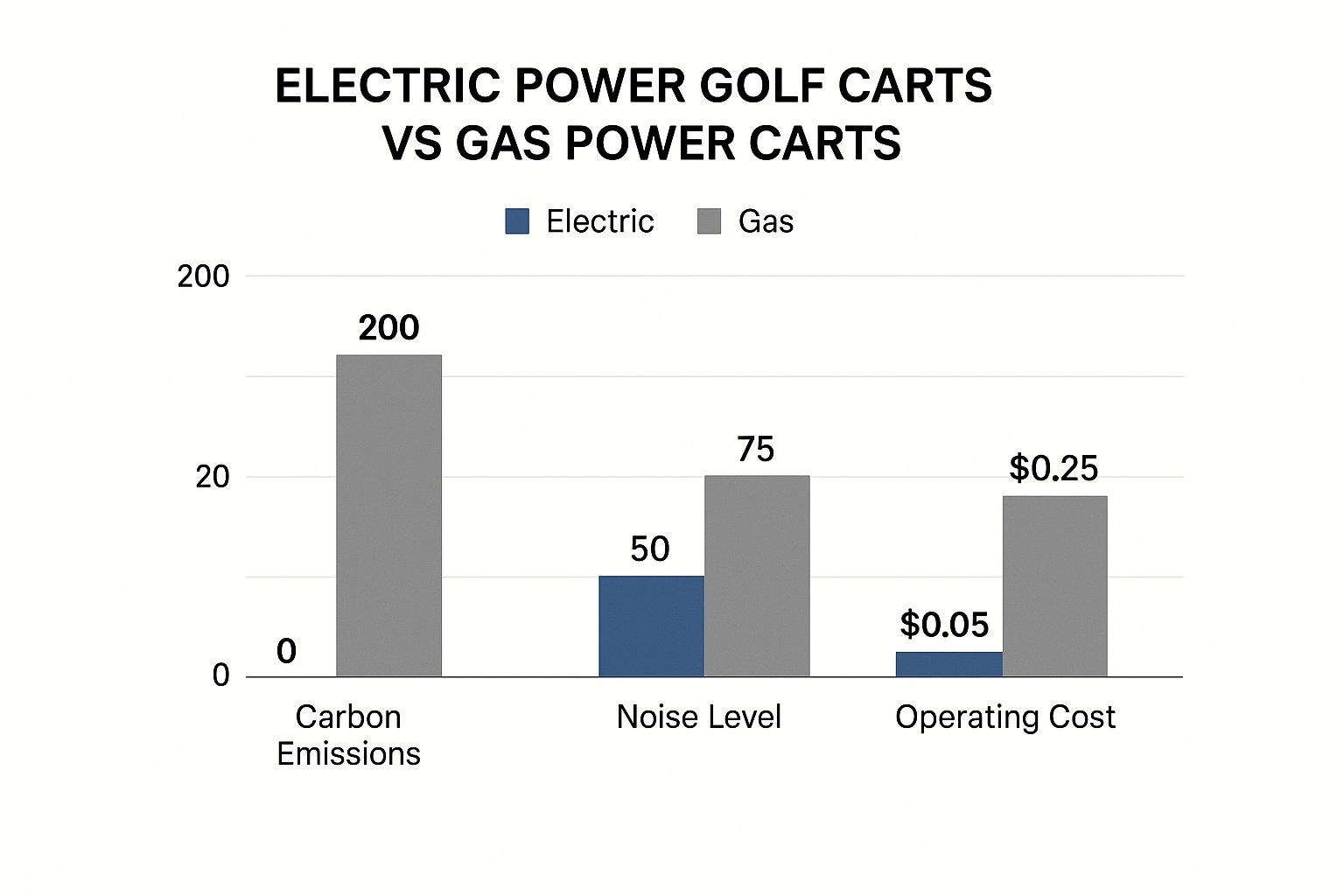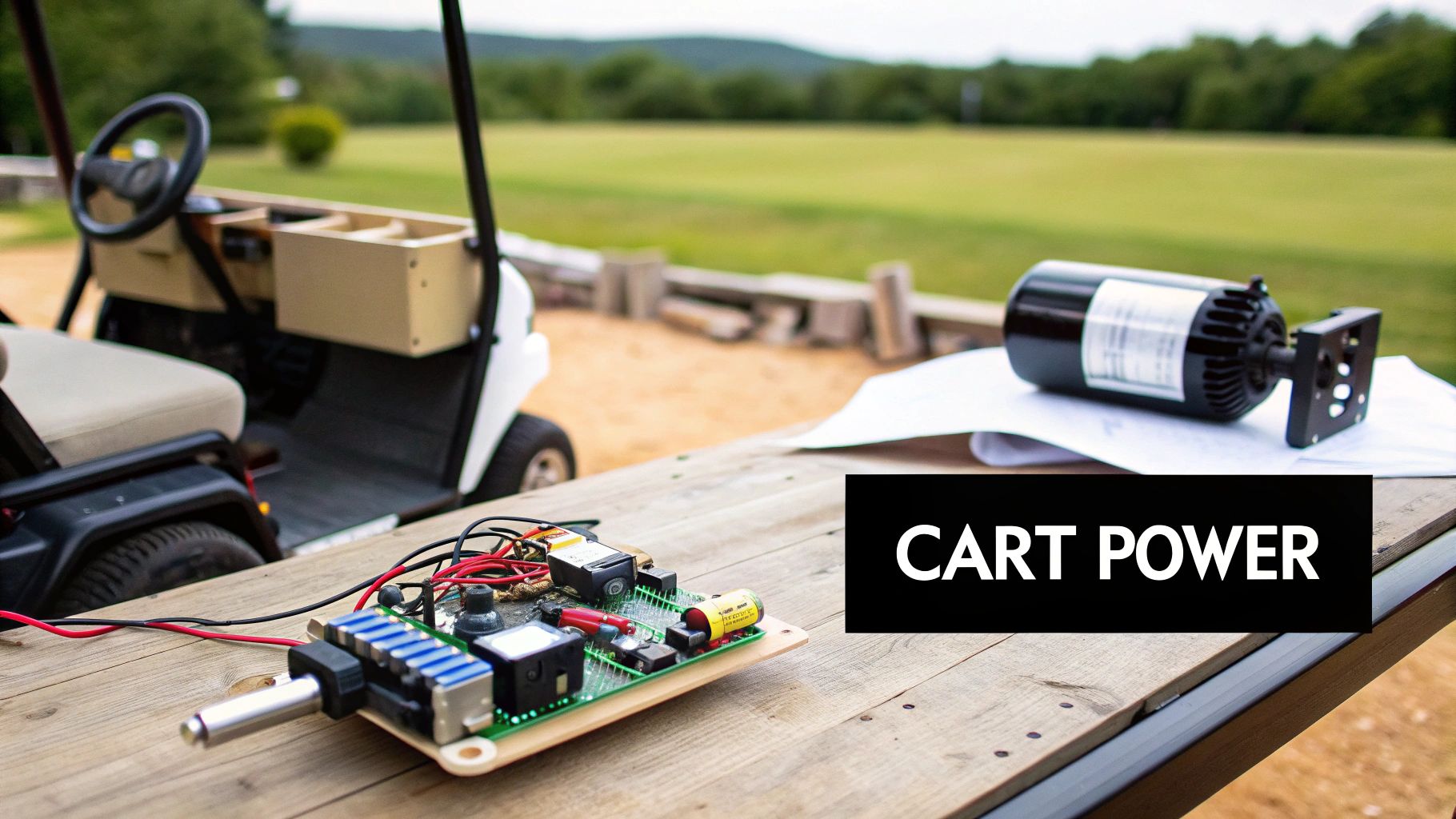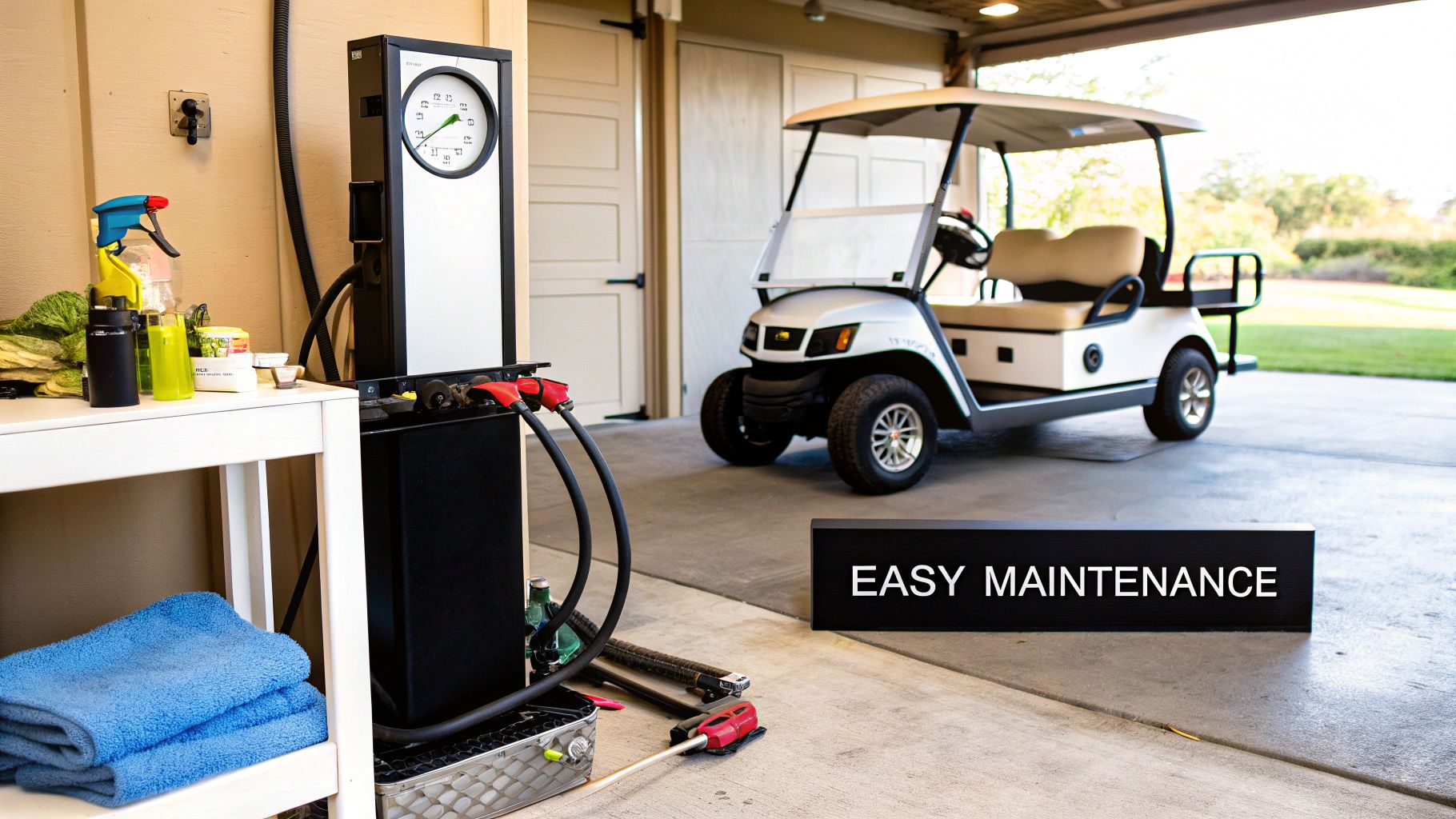A power golf cart is really just another name for an electric-powered golf cart. Once you only saw them cruising down the fairways, but now they’ve become a super popular and versatile choice for getting around in communities, resorts, and on big properties. Their appeal is pretty simple: they offer silent operation, zero emissions, and way lower running costs compared to their gas-guzzling cousins.
Why Power Golf Carts Are Everywhere
That quiet hum of an electric motor isn't just for the golf course anymore. These days, the power golf cart is a common sight in neighborhoods, retirement communities, and vacation spots. This shift mirrors a bigger trend toward smaller, more efficient personal electric vehicles—kind of like what we've seen with e-bikes.
So, what's driving this popularity? It really boils down to a few key advantages that make electric carts a smarter, more practical choice for how we live today. They give you a peaceful ride without the noise and fumes of a traditional gas engine, which makes them perfect for residential areas.
This isn't just a fleeting trend; it's a major market movement. The global electric golf cart market was valued at around USD 1.55 billion and is expected to hit USD 2.58 billion by 2033. That’s some strong and steady growth, showing just how many people are making the switch.
A power golf cart is more than a vehicle; it’s a lifestyle choice. It represents a move toward quieter, cleaner, and more community-friendly transportation.
The infographic below really spells out the practical benefits of choosing electric over gas.

As the data shows, the advantages are pretty clear. Electric carts produce zero emissions, are significantly quieter, and cost about a fifth of what a gas cart does to operate per mile.
Core Appeal Beyond the Fairway
The perks of a power golf cart go way beyond just being green or saving a few bucks. Their simplicity and ease of use are huge draws for a lot of people.
With far fewer moving parts than a gas engine, electric carts need a lot less maintenance. That saves owners time and money on upkeep. This reliability makes them the go-to choice for anyone who needs dependable, short-range transport.
Of course, while these carts provide a comfortable ride, many golfers still love the health benefits of walking the course. For those who want an electric boost without giving up the walk, you might be interested in the benefits of electric push carts for golfers. Their growing presence in all sorts of places just highlights a simple fact: they are practical, enjoyable, and efficient.
Understanding What Powers Your Golf Cart

To really get a feel for a power golf cart, it helps to peek under the hood—or in this case, under the seat. What makes it go isn't nearly as complicated as a car engine. The whole system boils down to three core components working in perfect sync: the motor, the batteries, and the controller.
Think of them as a simple but effective team. The batteries are the energy reserves, the motor is the powerhouse that turns the wheels, and the controller is the brain of the operation, telling the motor exactly what to do when you press the pedal.
Once you get a handle on how each part works, you’ll understand what separates a basic, run-of-the-mill cart from a true high-performance machine. It’s this knowledge that gives you the confidence to look at different models and see what truly drives their speed, hill-climbing power, and how far they’ll go on a single charge.
The Motor Is the Muscle
The motor is where the magic happens, turning electrical energy from the batteries into raw motion. It’s the heart of your cart's performance, and you’ll generally find two main types, each offering a totally different driving experience.
- DC (Direct Current) Motors: These are the old-school workhorses of the golf cart world. They’re reliable and get the job done without much fuss, making them a cost-effective choice. However, they can sometimes feel a bit sluggish on steep hills and don't offer the most thrilling acceleration.
- AC (Alternating Current) Motors: As the more modern option, AC motors are a game-changer. They're more efficient and powerful, delivering zippier acceleration and much better torque for climbing hills. They also often come with cool features like regenerative braking, which cleverly sends a bit of power back to the battery every time you slow down.
Your choice between an AC or DC motor will have a huge impact on how the cart feels on the course, especially if your club has a lot of hills or you just crave that instant power.
The Battery Is the Fuel Tank
If the motor is the muscle, the battery pack is the fuel tank. It's the single biggest factor determining your cart's range—how far you can cruise before needing a recharge. Just like with motors, there are two main technologies you need to know about.
Lead-acid batteries have been the standard for decades. They’re affordable and dependable, but they have their downsides. They're incredibly heavy and require regular maintenance, like topping off water levels.
On the other hand, Lithium-ion (Li-ion) batteries are the new gold standard. They are way lighter, charge much faster, and require absolutely zero maintenance. Plus, they deliver consistent power right until they're fully drained. If you want to dive deeper, you can learn more about the differences in our guide to electric trolley batteries.
A lithium-ion battery can shave over 300 pounds off a cart's total weight. This massive reduction leads to better efficiency, less wear on your tires, and a noticeable boost in handling and acceleration.
The Controller Is the Brain
Finally, let's talk about the controller—the unsung hero of the power golf cart. This little black box is the intelligent component managing the entire flow of electricity from the batteries to the motor.
When you press the accelerator, the controller reads that input and instantly delivers the precise amount of power needed for smooth, controlled movement. It's the brain that makes sure the muscle and the fuel tank work together in perfect harmony, giving you a seamless ride every time.
Choosing the Right Features for Your Needs

Picking out the perfect power golf cart isn't about finding the "best" one on the market. It's about finding the one that slots perfectly into your life. Think of it like buying a car—you wouldn't buy a two-seater sports car for a family of five, right? The same logic applies here.
Whether you're cruising through a quiet neighborhood, managing a huge property, or just making the trek to the first tee, the key is matching the cart's features to your day-to-day needs. It all starts with being honest about how you'll really use it. A simple cart built for flat, paved roads is going to complain loudly on a hilly farm.
By breaking down the most important features, you can build a mental checklist that makes the final decision a whole lot easier.
Matching Power to Your Terrain
The real muscle of your cart is its battery and motor. These two components dictate how far you can go and how well the cart handles hills, so it’s critical to think about where you'll be driving.
-
Battery Range and Charging Time: If you’re just planning short trips around the community, a standard lead-acid battery with a 25-40 mile range will probably do the trick. But for all-day adventures or longer drives, stepping up to a lithium-ion battery is a smart move. You'll get a 50+ mile range, faster charging, and a lot less waiting around.
-
Motor Power for Hills: Live somewhere with steep inclines? Don't even think about it—you need an AC motor. It delivers far more torque, giving you the grunt needed to climb hills without slowing to a crawl. A DC motor will get the job done on flat ground, but it'll struggle when the going gets tough.
Think of your cart's motor like a car's engine. A DC motor is like a reliable four-cylinder, great for everyday driving on flat ground. An AC motor is the V6, giving you that extra power and responsiveness when the road gets challenging.
Sizing Up Your Cart
Once you've got the power sorted, it's time to think about the cart's physical setup. The first, most obvious choice is seating. How many people are you bringing along for the ride? In the United States, 2 to 4-seater carts are king, fitting the needs of most small families and golfers. States with large retirement communities, like Florida, are huge markets for these quiet, low-emission vehicles. You can check out more about the U.S. electric golf cart market trends on grandviewresearch.com.
Next up is storage. Do you need a big cargo box on the back for tools and gear, or is a little under-seat storage enough for your wallet and phone? And if you're a golfer who loves to walk the course but could use a little help with the bag, there are other great options out there. Our guide on what to know before buying an electric golf push cart is packed with useful insights.
Finally, a big one: do you plan on driving it on public roads? If so, you have to make sure your cart is street-legal (or can be made street-legal). This usually means adding a specific package of safety gear:
- Headlights and taillights
- Turn signals and brake lights
- A windshield
- Seat belts for all passengers
- Rear-view mirrors
Always check your local Low-Speed Vehicle (LSV) rules before you buy, because the requirements can change a lot from one town to the next. Getting these details right ensures your power golf cart is fun, functional, and fully compliant.
Simple Ways to Extend Your Cart's Life

A power golf cart is a serious investment, and just like any other vehicle, it needs a little TLC to perform its best. The good news? You don't have to be a seasoned mechanic to keep your cart in top-notch shape. A few simple, consistent habits are all it takes to protect your ride and keep it running smoothly for years.
Think of it as a simple wellness routine for your cart. Spending just a few minutes each month on basic upkeep can prevent major headaches down the road, boost performance, and squeeze every bit of life out of its most important parts. This proactive mindset doesn’t just save you a bundle on future repairs; it ensures your cart is always ready to roll when you are.
The whole routine boils down to the basics: keeping an eye on the battery, tires, and electrical connections. Once you get these simple checks down, you'll feel more confident and get way more enjoyment out of your cart.
Master Your Battery Care
The battery is the heart and soul of your electric cart. Its lifespan is directly tied to how you treat it, so proper charging and maintenance are absolutely non-negotiable if you want to get the full 4 to 6 years out of a standard lead-acid model.
It all starts with smart charging. The golden rule is to charge your cart after every single use—even if you just took it for a quick spin around the block. This habit prevents the battery from draining too low, which can cause permanent damage and slash its overall capacity over time.
A well-maintained battery isn't just about lasting longer; it's about delivering consistent power. Neglecting battery care is the fastest way to see a drop in your cart's range and hill-climbing ability.
For carts with traditional lead-acid batteries, a monthly water check is a must. Here's how to do it right:
- Use Distilled Water Only: Never use tap water. It’s full of minerals that will build up and ruin the battery cells.
- Check Levels After Charging: Always top off the water after the battery is fully charged to prevent it from overflowing during the charging process.
- Keep Terminals Clean: Mix a little baking soda and water to create a paste, then use an old toothbrush to gently scrub away any corrosive gunk on the terminals. A clean connection is a happy connection.
Perform Simple Routine Inspections
Beyond the battery, a few other quick checks will keep your power golf cart running safely and reliably. These tasks only take a few minutes but make a world of difference in your cart’s performance and your own safety.
First, give your tires a once-over every month. Check the air pressure to make sure it matches the manufacturer’s recommendation, which is almost always printed right on the tire’s sidewall. Properly inflated tires give you a much smoother, more efficient ride and help them wear down evenly.
Next, do a quick walk-around to check your lights and brakes. If your cart is street-legal, make sure the headlights, taillights, and turn signals are all working. Give the brake pedal a few pumps to confirm it feels firm and engages smoothly. And don't forget to keep that windshield clean for clear visibility, especially if you enjoy evening cruises. These simple habits are what make every trip a safe one.
Exploring the Latest Golf Cart Innovations
Today’s power golf cart has come a long way from its humble beginnings. It’s no longer just a simple buggy for getting from one hole to the next; it’s a sophisticated piece of technology loaded with features that boost performance, efficiency, and the entire ride.
These aren't just minor tweaks. The modern cart is becoming a smarter, more capable personal vehicle, and a few key innovations are leading the charge.
Leading the pack are lithium-ion batteries. Think of them as the high-performance engine upgrade for the electric cart world. They are much lighter, charge in a fraction of the time, and deliver a far longer range than the old-school lead-acid batteries they’re replacing.
This shift mirrors a massive trend in the broader electric vehicle market. In fact, global demand for lithium-ion batteries in vehicles jumped by an incredible 65% in a single year. That’s a loud and clear signal of their superior performance and why everyone is making the switch. You can dig into more details on this trend by reading the full research on polarismarketresearch.com.
Smart Technology on the Go
Beyond just the battery, the modern power golf cart is also getting a brain. Manufacturers are building in intelligent features that used to be reserved for cars, making the carts more intuitive and efficient.
- Regenerative Braking: This is a seriously clever system. It captures the energy that's usually wasted when you slow down and feeds a small amount of power back into the battery. It’s like getting a tiny, free recharge every time you hit the brakes, which helps squeeze a little more distance out of every charge.
- Digital Dashboards: Say goodbye to basic needle gauges. New carts sport sleek digital displays showing you everything in real-time—from your precise battery level and speed to diagnostic alerts that keep you in the know.
- Connectivity Options: It's common now for new models to come with Bluetooth speakers and USB charging ports. This means you can stream music or your favorite podcast and keep your phone charged, adding a nice touch of convenience to any trip.
The chart below from Grand View Research shows just how much these tech upgrades are shaping the market and what people are buying.
As the visual makes clear, the market has a strong preference for electric models. Their technological advantages and smaller environmental footprint are what's really driving the industry forward.
All these upgrades prove that golf carts are keeping pace with the big shifts in personal transportation. They're evolving from simple utility vehicles into refined machines that offer a smarter, cleaner, and way more enjoyable ride, whether you're on the course or just cruising around the neighborhood.
Of course. Here is the rewritten section, designed to sound completely human-written and natural, following all your specified requirements.
Common Questions About Power Golf Carts
Even after you've done your homework on the tech and features, it’s totally normal to have a few last-minute questions before pulling the trigger on a power golf cart. This is a big purchase, after all, and getting straight answers to those lingering thoughts can give you the final boost of confidence you need.
From battery life to how far you can really drive and the rules of the road, some questions pop up again and again. We’ve rounded up the most common ones from new buyers to give you clear, no-nonsense answers. Think of this as the final checklist to make sure you’re ready to hit the road (or the fairway) with ease.
How Long Does a Power Golf Cart Battery Really Last?
A battery's lifespan is a huge deal for any owner, and it really boils down to two things: the type of battery you’ve got and how you treat it. A little TLC can make a massive difference in how many years of service you get.
Traditional lead-acid batteries are the old-school workhorses. With consistent care—like topping off the water levels every month and making sure they never drain all the way—you can expect them to last somewhere between 4 to 6 years. They need a bit of hands-on attention but come with a lower price tag upfront.
On the flip side, modern Lithium-ion (Li-ion) batteries are a major leap forward in longevity. These power packs often last 8 to 10 years or even longer and are completely maintenance-free. While they cost more initially, their extended lifespan and set-it-and-forget-it nature make them the more popular and cost-effective choice in the long run.
What Is the Real-World Range on a Single Charge?
Knowing how far you can cruise on a single charge is crucial for planning your day. The actual range of a power golf cart isn’t just one simple number; it can change based on a few key factors.
The biggest player here is your battery. A standard cart with lead-acid batteries will typically get you between 25 to 40 miles on a full charge. That's usually plenty for a round of golf or quick jaunts around the neighborhood.
But if you want more freedom to explore, a cart with a lithium-ion battery is your best bet. These models can easily cover 50 to 60 miles or more without breaking a sweat.
Keep in mind that your cart's range is also shaped by other things. Hilly terrain, the weight of your passengers and gear, and even your tire pressure can affect how much mileage you get out of each charge.
Can I Make My Power Golf Cart Street Legal?
Yes, in many places, you absolutely can! The catch is that the rules and regulations can vary wildly from one town or state to another. The most important thing is making sure your cart meets the official criteria for a Low-Speed Vehicle (LSV).
To be considered an LSV, a cart usually needs a top speed between 20 and 25 mph. More importantly, it has to be kitted out with a specific list of safety features. These almost always include:
- Headlights, taillights, and brake lights
- Front and rear turn signals
- A windshield and seat belts
- Rear-view and side-view mirrors
- A Vehicle Identification Number (VIN)
Before you buy anything, it is critical to check your local and state regulations. A quick call to your local DMV or a browse on their website can clear up all the requirements, ensuring you get a cart that’s legal to drive on public roads where you live.
What Is the Difference Between AC and DC Motors?
Understanding the motor in your golf cart is like knowing the difference between a family sedan's engine and a sports car's. It has a direct impact on how your cart accelerates, climbs hills, and uses energy.
You can think of it as old-school tech versus new-school tech.
- DC (Direct Current) Motors are the traditional standard. They’re reliable and have been around for ages, offering steady, predictable performance on flat ground. However, they're generally less efficient and can feel a bit sluggish when you’re trying to tackle a steep incline.
- AC (Alternating Current) Motors are the modern, more powerful option. They deliver much better acceleration and have the extra torque you need to climb hills without losing speed. AC motors also allow for regenerative braking, a cool feature that captures a bit of energy when you slow down and sends it back to the battery.
While carts with AC motors often come with a higher price, their superior performance, especially on tricky terrain, makes them the go-to choice for most drivers today.
Ready to enjoy the walk without the work? The Caddie Wheel transforms your existing push cart into a powerful electric caddy, letting you conserve energy and focus on your game. Discover the effortless way to walk the course at https://caddiewheel.com.


Share:
Your Guide to the Best Golf Cart Cooler Bags
Your Guide to an Electric Golf Cart Caddy